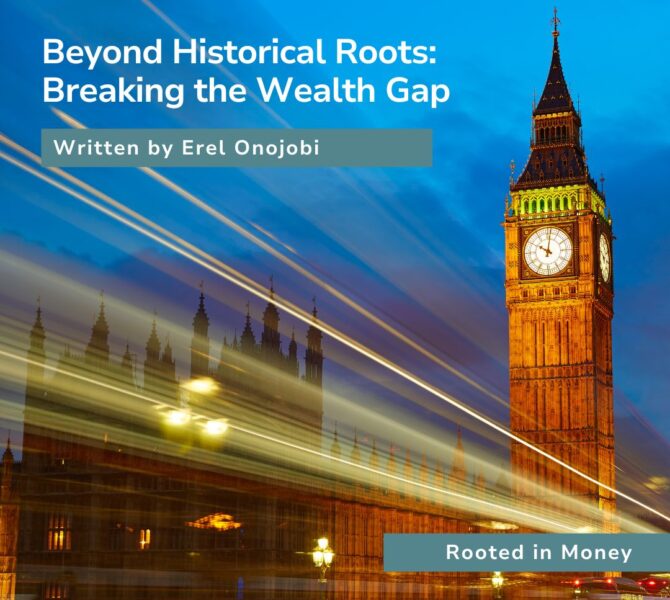The racial wealth gap did not appear by accident.
It was built over time through policies, practices, and decisions that systematically excluded Black and other minoritised communities from building and passing on wealth. Those historic patterns continue to shape who holds assets, who carries debt, and who has influence over the systems that govern our financial lives.
Housing remains one of the clearest examples of this legacy. After the Second World War, new mortgage schemes and suburban development created opportunities for some to own homes and build equity, but discriminatory practices in both public and private sectors excluded many Black and Asian families. Redlining in the United States, and subtler forms of bias in the UK, meant that access to affordable credit and good-quality housing was systematically denied. Over time, this unequal access to ownership became a key driver of the racial wealth gap, influencing who could pass on stability and security to the next generation.
Financial services mirrored these divisions. For decades, mainstream banks and lenders either excluded or exploited minoritised communities. Even today, credit scoring models penalise those with irregular incomes, migrant histories, or community-based savings patterns. Payday lenders, doorstep credit, and rent-to-own schemes continue to target those shut out from mainstream finance, trapping many in cycles of high-cost debt. These outcomes are not accidental; they result from systems built without the realities of our communities in mind.
Policies framed around financial resilience often miss this point. They suggest that people’s struggles are the result of poor budgeting or lack of knowledge, rather than centuries of structural inequality. In truth, many people on low incomes are exceptionally skilled at managing scarce resources. They stretch every pound, plan for uncertainty, and make difficult trade-offs.
What they cannot do is redesign a system that was never built for them.
To achieve genuine financial inclusion, we must start with honesty. We need to understand how racialised wealth disparities were created and how they are maintained. Without this clarity, we cannot hope to change them.
That means shifting policy away from fixing individuals and towards fixing systems. Instead of teaching people how to cope better with debt, we should ask why debt is so unevenly distributed in the first place. Instead of asking communities to adapt to the system, we should enable them to shape it.
A more transformative agenda would embrace a reparative approach that recognises the harm caused by exclusion and focuses on restoring what was denied. This could mean targeted investment into Black and minoritised communities, not as charity but as repair. It could mean supporting community-led credit unions, cooperatives, and asset vehicles that return control to the people most affected. It could mean reforming regulation to enable culturally appropriate financial products that reflect how our communities actually save, lend, and support each other.
Financial inclusion must move beyond the question of participation to one of power and ownership. The goal is not to draw people into an unequal system but to build new systems that work for everyone. That takes imagination, persistence, and shared commitment from policymakers, funders, and communities alike.
This is why Power to Prosper exists.
Power to Prosper is a national programme that supports communities to build power, grow ownership, and influence the systems that shape their economic lives. We work with local partners in places like Lambeth, Newham, Manchester, and Nottingham to create the infrastructure for community-led financial design, from collective asset models to new financial pathways that reflect our cultural and social realities. At its heart, Power to Prosper believes that people closest to the problem are closest to the solution.
We do not see poverty as an individual failing. It is the result of design choices that have favoured some and marginalised others. If poverty and debt were designed in, then they can be designed out. But that will not happen through top-down reform alone. It requires giving communities the opportunity, space, and resources to imagine and build something different. To create systems of ownership, finance, and support that are aligned with our values and suited to our needs.
These must become more visible and urgent conversations. When we talk about closing the racial wealth gap, we should not stop at financial education or inclusion as defined by mainstream institutions. We should be talking about ownership, power, and repair, about rewriting the rules of who gets to hold wealth, how it is generated, and for whose benefit.
Acknowledging history is not about looking back; it is about understanding the present and shaping a better future. The legacy of exclusion is visible in every measure of inequality today, but so too is the potential for change. Across the country, communities are already building new models of financial life, proving that inclusion and fairness can go hand in hand.
To truly prosper, power must be shared, systems redesigned, and wealth built collectively. Only then can financial inclusion become more than a slogan; it can become a lived reality.
——
Author Bio: Erel Onojobi is the Power to Prosper Programme Director at the Runnymede Trust and New Economics Foundation. In her role, she directs the multi-year Power to Prosper programme, which is focused on addressing the racialised nature of poverty and debt, building power and building assets among grassroots organisations in Black and minoritised communities in regional hubs across the England. Before joining the Runnymede Trust, Erel worked at Impact on Urban Health and has a background that includes extensive work in financial Inclusion, youthwork and the voluntary sector more generally.

